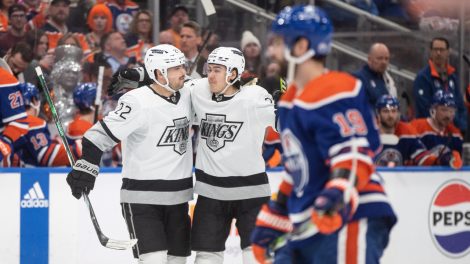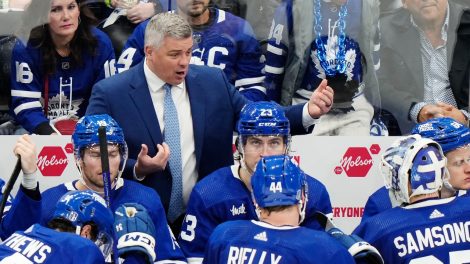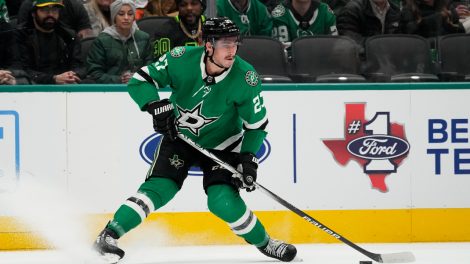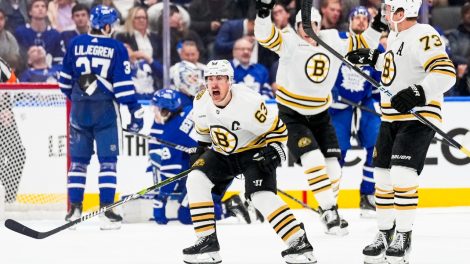Rogers is at the halfway point of the 12-year, $5.2-billion national NHL broadcast rights package, and no one could’ve predicted what came in year six: a global pandemic, causing every major sports league to come to a sudden stop.
While many are in a wait-and-see holding pattern when it comes to the grand return of professional sports in North America, behind the scenes there are ever-evolving planning sessions in progress.
“All of the feedback we’re getting from fans and advertisers and all our partners is, there is an intense, pent-up demand to have sports back and to have sports available on whatever device you want to consume it on,” Rogers Sports & Media president Jordan Banks said during a media event Monday.
During the virtual event, Banks shed some light on the company’s sports-first strategy in an ever-changing media landscape – one that has seen a seismic shift over the past few months as the COVID-19 pandemic has brought the sports industry to a standstill and changed the way the public is consuming content.
“I think one of the things that’s been so destabilizing around COVID is the fact that it is just so unpredictable,” he said. “There are no crystal balls here, there is no blueprint that is allowing us to determine, ‘This is what we’re going to do and when we’re going to do it,’ so that shifting ground has really forced us to rethink everything.”
“Everything” includes, of course, not just how and when sports return — but what they’ll look like when they do.
“With no fans, one of the things that you’re going to see is we’re going to be able to have some very interesting broadcast angles that we weren’t able to have before, which are going to delight some fans, and clearly we’re going to have a lot more focus on the coaches and the players themselves,” said Banks. “I think it’s going to provide for just a different environment, and one that we’re excited about, because I think that there’s a lot of opportunity in redefining what it is to not only broadcast, but to watch these games that we hope will be coming back in the summer.”
It’s not just the players that revel in the booming support (or antagonistic bellows) from those packing the stands at the rink – crowd noises and the sights and sounds that come with a packed barn are a major contributor to the overall look and feel for the at-home viewer, too.
“How do you broadcast games without any of that and ensure that the fans and the viewers on the other side are equally as fired up as they would’ve been if fans would’ve been in the building?” said Banks, adding that he, his team, and the NHL are paying close attention to how the Bundesliga in Germany and England’s Premier League are conducting fanless broadcasts. Broadcasters of both leagues have plugged in fake crowd noise to simulate the general experience.
For NHL games, a lot of the solutions will be driven by technology.
“There might be some CGI in there, there might be some pumped-in noise, there might be other forms of characters or emojis. We’re working through all of that in real-time, and I think what we’re going to see is, it’s obviously going to be different, but some of the initial prototypes that I’ve seen are actually pretty exciting, and really do bring you back to, ‘Hey, I’m watching a game and there are fans cheering, and that in turn makes me feel like I’m part of the game,’” Banks said.
Another major factor? Location.
“If there’s a hub city in Canada, we most likely will have people in the building producing and potentially on-air,” said Banks. “If there are only hub cities in the U.S., we won’t – and that’s something, literally, we’re talking to the NHL about on a daily basis.”
The NHL has been assessing 10 NHL cities – three of which are in Canada – for its return to play. The latest reports point to Las Vegas being one of the two hubs, which leads to plenty of speculation that the other will be one of Vancouver, Edmonton or Toronto to fulfill the league’s desire to have one hub on either side of the border. (The Canadian government announced last week that it would allow incoming NHL teams to quarantine collectively, not separately, thus opening the door for hockey to be played in Canada.) An official announcement is expected later this week as the NHL prepares to move forward with its four-phased return-to-play plan.
While it’s the “bread and butter” of Rogers Sports & Media, hockey isn’t the only sport in question right now. Should the NBA resume later this summer, and if the MLB is able to start up its shortened season around the same time, the jam-packed sports schedule will put the demand on all platforms at an all-time high.
“There is a potential and a possibility that we’re going to have three major sports leagues all playing at the same time in a relatively condensed calendar,” said Banks, who on Monday also explained that part of his mission moving forward is to “spend way more time, way more effort and allocate way more resources” to direct-to-consumer offerings like Sportsnet NOW as fans’ content consumption continues to “dramatically change.”
“So, most important for us is to ensure that all fans know that if you want to watch the Leafs or you want to watch the Canucks or you want to watch the Raptors, you want to watch the Blue Jays, here’s exactly when you can watch them and here’s where and how you can watch them,” he said.
Banks described conferences and whiteboards with “30 different scenarios” – each spelling out different outcomes, various game and tournament formats, hub city locations, Canadian teams’ outlooks and number of games.
“All of those scenarios play out, and we have solutions and structures around all of them,” he said. “Right now we really are waiting for the leagues to determine when it is go time and to ensure that go time will mean the players and other personnel can do it in a safe and healthy way.”
[relatedlinks]










